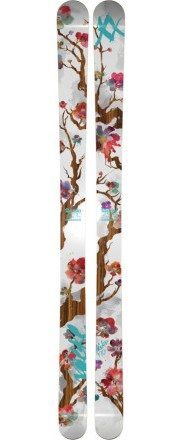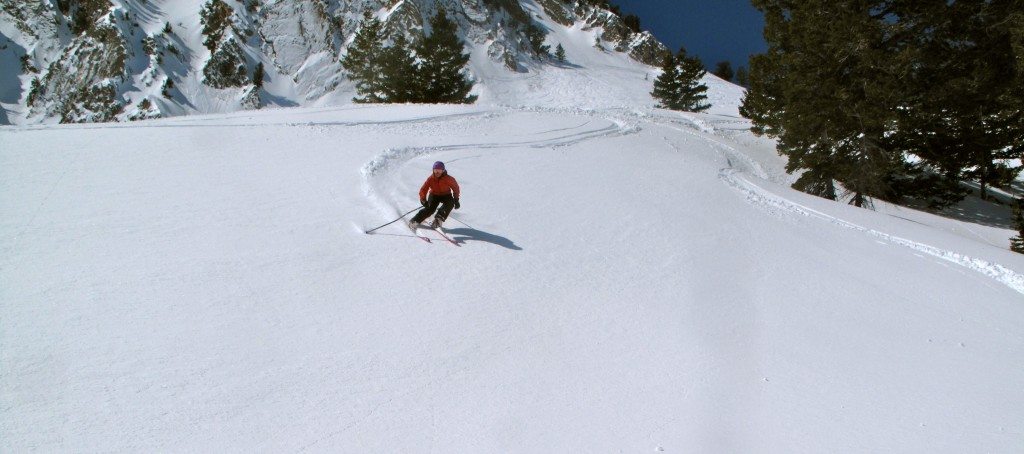
Ski: 2010-2011 Volkl Kiku, 170 cm
Dimensions (mm): 137-106-122 Turn Radius: 23.6 meters
Boots / Bindings: Rossignol Radical World Cup 110 / Marker Barons / DIN (6)
Mount Location: Factory recommended mark
Test Location: Alta, Arapahoe Basin, and all over Colorado
Days Skied: 50
Growing up as a racer in Stowe, Vermont, I spent my days on skis looking for speed. But after a move to Colorado last year, I put my race skis in the closet and began searching for a new, all mountain ski. I asked a lot of questions and gathered even more opinions. And I definitely had some reservations: Would any of the women’s skis on the market be stiff enough to rip down groomers at top speeds, but still be fun and manageable in the trees? After much deliberation, I settled on the Volkl Kiku and hoped for the best.
As I left Arapahoe Basin in early November, I was elated after an awesome day. Not only had it been my first day skiing out West (I grew up skiing the icy Northeast), but I knew I had chosen the right ski. The Kiku ripped. Of course, the early-season, hard pack groomers were not indicative of what I would be skiing the rest of the winter, but that made me all the more excited to be on this ski. The group I was skiing with that day was not quite on the same ability level as me, and I was too eager to wait around. It just felt so good to get my legs pumping again and carving fast, smooth turns, so I took off by myself for the rest of the day. I was amazed at the stability I felt, especially since I wasn’t on GS skis anymore.
The Kiku is marketed as a big mountain powder ski that can also be used every day, all over the mountain. I certainly agree with this description. In tougher conditions, the Kiku displays durability and stability, yet when skied in their ideal environment—deep powder—they are suddenly transformed into light, floating skis.
The dual-nature of the ski is impressive, a beautiful result of Volkl’s Elongated Low Profile (ELP) rocker technology combined with a full wood core. For a ski only three years into production, their technology is advanced and effective. The rockered design gives the ski three different flex regions: the front (shovel) has the most stiffness to provide the most stability, and the middle has a medium-stiff flex that provides a more fluid transition to a softer tail that enables easier turns.
And it shows: this ski wants to carve. I was easily able to arc them and find big angles at medium and high speeds. These qualities could also be attributed to the multi-layered wood core, made of a dense ash and lighter poplar. The differences in stiffness of the wood let the skis’ versatility shine in all conditions.
I spent an entire season on the Kiku, so I really got a good feel for how it handles all over the mountain. I was having a great winter, hitting up many ski areas around Colorado when Spring Break ’11 rolled around. Though I was tempted (only for a second) to follow my friends to warmer destinations, I instead looked to some of the epic places I had yet to ski. Utah was the clear winner, as it was a mere eight-hour drive away and a I had a free place to stay. As I was driving up Little Cottonwood Canyon toward the famed Alta, I was expecting a great day. I was not expecting, however, the three best days of skiing of my life.
It had been snowing consistently in the Wasatch. Alta’s base was deep and soft, and the first morning I arrived there was about a foot of fresh snow. Although I had been skiing for a few months already, I had not yet had a really epic powder day. I was extremely excited. I took a quick warm-up run down Main Street off of Collins with some friends from the area, then proceeded back up to officially start the day on High Rustler.
As I made powder turns down the steep terrain, I finally felt what the Kikus were made to do. The rockered tip and tail allowed me to truly float through the powder, and I didn’t notice or experience any significant stiffness in the tip, as I had in other conditions. They felt light, and yet, when I got them back into the choppier, tracked snow, they had the stability to plow through.
I spent most of the day playing off the Supreme lift, ducking in and out of the woods. I had read in other reviews that the skis did not handle well in the trees, but I found that they were great. They turned quickly and easily enough for me, but I do have a slightly shorter ski. The 170s, for my size and ability, are a bit shorter and more manageable for making those quick turns. If I had opted for the 178s, while perhaps more fun to charge on, they would have likely been more work in the trees. But, as easy as I felt it was to ski the Kiku in the woods, I was pretty aggressive and forward on the skis. If I got back or let up a little bit, the ski took over and took off. They will definitely make quick turns, you just have to be thinking one step ahead of the ski.

I wouldn’t call the Kiku a super forgiving ski (especially at high speeds in super choppy snow), but it does allow you to recover most of the time. If you are hauling just a bit too fast, they are easy to throw sideways and scrub speed. Toward the end of my first day at Alta, despite the soft base, the snow was getting a bit crusty up around Catherine’s. Though it was snow I would typically be more cautious in, the Kikus felt solid. I was easily able to pivot them down the narrow sections, and then let them run at the bottom. They really transition well between all conditions.
It continued to snow for the next two days at Alta. While there was not a full foot again, the snow continued to stay soft and I could find fresh tracks late into the day. As I mentioned before, though the skis certainly seemed happiest in powder, they also crave speed. The run, Extrovert, has a steep, groomed pitch at the bottom, and it was extremely fun to point the skis down the hill and go. Once they are up to speed, it was extremely easy to roll them over, carving and linking every turn. The Kikus handled extremely well in groomed snow with a couple inches of chopped up fresh on top. I know I’ve been nervous going fast in similar conditions on other skis, but the Kikus were strong and it was no problem.
I was also introduced to backcountry skiing this season, and was lucky enough to get some Marker Barons for Christmas. I did a few tours, and hopefully will do more next season. I found the Kikus to be a great backcountry ski. The wood core makes them light for touring (though the Barons are a bit heavy), and they perform beautifully in fresh backcountry snow.
The only real issue I found with the Kikus was that they did lose some stability while going at high speed in super choppy snow. They tended to wash out a little bit, but when I slowed down, they handled the snow just fine. So this, plus the fact that it is important to stay on your game while making quicker turns, and that tree skiing might not be quite as good with a longer length, were the only potential pitfalls I came across. Not bad, Volkl.
If you’re looking for an all-around ski and you like to ski hard, I think this ski is pretty perfect. I mean, could you do a whole lot better than a ski that is built for powder, loves speed, and is maneuverable, light, and stable? Plus, this season’s topsheets are really beautiful, with pink and blue Japanese-style lotus flowers; they garnered many compliments in the lift lines and attracted a lot of attention.
All year I have been enthusiastically recommending this ski to my girlfriends, but only if they’re strong. The Kiku is stiff as far as woman’s skis go, and they are not meant to be skied casually. Don’t let those pretty pink flowers fool you.
For the upcoming season, Volkl has tweaked the Kiku a bit, and obviously, they think they have improved it. For starters, it’s a bit wider (139-107-123mm), features a carbon fiber layer (“for added pop and stability”) and has a higher tip profile.
If, in fact, Volkl has managed to improve the Kiku, I’ll be very impressed. Of course, there’s only one way to find out, and you can be sure that we will be letting you know.


Great review of the Volkl! I was able to test this ski but not to the extent you were able to. It was a slushy and kinda warm day but it was still amazingly fun which leaves me wanting more. After reading your review I am even more amped to try these Volkls in some deeper snow and more ideal conditions. Thanks for the review and happy skiing!
I bought these ski’s after I demo’d them in Snomass last year. I plan on using them all mountain. I never ski’d a powder ski before so when I hit the powder with the kiku wow. I was a little nervous this year when I picked up the ski’s after adding bindings. I want to try a few races in the crusty mw before I go to Colorado. Reading this review I think Ill be fine.
Any idea how much they weigh, please?
Hi Clarky,
The 170 Kiku weighs 1900 g (4 lbs 3 oz) per ski, or 3800 g (8 lbs 6 oz) for the pair.
The 178 Kiku weighs 2000 g (4 lbs 6.5 oz) per ski, or 4000 g ( 8 lbs 13 oz) for the pair.
Julia
Just got some ’13 for my sister. What do you think about mount point? There are lines for neutral and +1, +2. Sister is 53 and skis like a racer. Thanks!
Hi DJ!
I mounted mine on the recommended line, which worked well for me! I haven’t played around too much with the mounting position for the Kiku, so I can’t speak to how differently it will ski at +1 or +2, but I think the recommended line will be just fine. Thanks for reading!
Julia
I know it has been a while since this review but has a ski stood out as a viable replacement for the Kiku? I have tried a lot of different skis to replace my 179 Kiku’s but nothing seems to feel just right so I am open for suggestions. No one seems to make full-rocker women’s skis so I have been trying some 180 camber but they feel too long while the 172 feel too short.